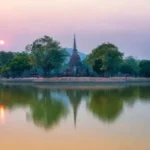Chhattisgarh, often referred to as the “Rice Bowl of India,” is a state blessed with breathtaking natural beauty, rich tribal culture, dense forests, majestic waterfalls, and ancient temples. Nestled in central India, this offbeat travel destination offers an unmatched blend of nature, history, and adventure. Whether you’re a nature enthusiast, a history buff, or a spiritual seeker, Chhattisgarh has something to offer.
In this blog, we’ll uncover the 20 top tourist places to visit in Chhattisgarh that will make your travel itinerary truly unforgettable.
—
1. Chitrakote Waterfalls – The Niagara of India
Often dubbed the Niagara Falls of India, Chitrakote is the widest waterfall in India, located near Jagdalpur in Bastar district. During the monsoon, it presents a stunning sight with its massive water flow.
Best Time to Visit: July to October
Attractions: Boating, photography, and scenic views.
—
2. Tirathgarh Waterfalls – A Stunning Cascade
Located in the Kanger Valley National Park, Tirathgarh Waterfall is known for its milky white appearance and lush green surroundings. It’s a favorite picnic and photography spot.
Best Time to Visit: Monsoon and winter
Tip: Combine with a trip to Kutumsar Caves nearby.
—
3. Kanger Valley National Park – Biodiversity Hotspot
A treasure trove of biodiversity, Kanger Valley National Park is home to unique flora and fauna, deep gorges, and limestone caves.
Things to Do: Jungle safari, visit to Kutumsar and Dandak caves.
—
4. Barnawapara Wildlife Sanctuary – For Nature and Wildlife Lovers
Located in Mahasamund district, this sanctuary is ideal for wildlife enthusiasts. You can spot leopards, wild boars, and sloth bears here.
Best Time to Visit: November to June
Stay Options: Forest lodges and eco-resorts.
—
5. Bhoramdeo Temple – The Khajuraho of Chhattisgarh
Built between the 7th and 11th centuries, this temple complex is adorned with erotic sculptures and intricate carvings, reminiscent of Khajuraho.
Location: Kawardha district
Ideal For: History lovers and architecture buffs.
—
6. Sirpur – A Spiritual and Historical Hub
Sirpur is an archaeological site that houses ancient Buddhist monasteries, Shiva temples, and remains of a thriving civilization.
Key Sites: Laxman Temple, Buddha Vihara
Best Time: October to February
—
7. Mainpat – The Mini Tibet of Chhattisgarh
A lesser-known hill station, Mainpat is known for its Tibetan settlements, stunning waterfalls, and cool climate.
Don’t Miss: Tiger Point, Fish Point, and local Tibetan food.
—
8. Rajim – The Prayag of Chhattisgarh
Known for the confluence of three rivers (Mahanadi, Pairi, and Sondur), Rajim is an important pilgrimage center. The Rajim Kumbh Mela attracts thousands of devotees annually.
—
9. Dantewada – Where Faith Meets Nature
Home to the sacred Danteshwari Temple, Dantewada blends spirituality with natural beauty. It’s also the gateway to Bastar’s tribal heartland.
—
10. Jagdalpur – The Cultural Capital of Bastar
A major town in the Bastar district, Jagdalpur is rich in tribal heritage, folk art, and natural wonders.
Visit For: Bastar Dussehra, local markets, and tribal museums.
—
11. Bastar Palace – A Glimpse of Royalty
Built by the rulers of Bastar, this palace offers a peek into royal architecture and tribal legacy. It’s centrally located in Jagdalpur.
—
12. Kutumsar Caves – Underground Marvel
One of the longest natural caves in the world, Kutumsar Caves are a part of Kanger Valley National Park and feature stunning stalactites and stalagmites.
—
13. Maitri Bagh Zoo – Bhilai’s Favorite Family Spot
Developed by the Bhilai Steel Plant, Maitri Bagh is a zoo and a large garden perfect for families. It also has a musical fountain and toy train.
—
14. Dhamtari – Gateway to Ravishing Dams
Known for its reservoirs and forests, Dhamtari is also close to the scenic Gangrel Dam, perfect for water sports and picnics.
—
15. Sitanadi Wildlife Sanctuary – For Bird Watching and More
Named after the Sitanadi River, this sanctuary is rich in flora and fauna and is a popular spot among bird watchers and nature lovers.
—
16. Raipur – The Capital City
While Raipur is a modern city, it offers cultural experiences through Mahant Ghasidas Museum, Nandan Van Zoo, and various temples.
Shopping Tip: Explore local handicrafts at Chhattisgarh Haat.
—
17. Bilaspur – Cultural Capital of the State
Known for its kosha silk sarees, Bilaspur also houses Ratanpur temple and the scenic Arpa River. A perfect mix of tradition and urban life.
—
18. Malhar – An Archaeologist’s Delight
One of the oldest known cities of Chhattisgarh, Malhar is filled with ancient ruins, temples, and sculptures dating back to the Kalachuri dynasty.
—
19. Narayanpur – Explore Tribal Art and Crafts
Famous for bell metal handicrafts and tribal jewelry, Narayanpur is a cultural treasure trove. Don’t miss the local weekly haat (market).
—
20. Kawardha – Tranquil and Spiritual
Nestled in the Maikal hills, Kawardha is famous for the Raj Mahal and nearby Bhoramdeo Temple. Ideal for a quiet, spiritual getaway.
—
Final Thoughts
Chhattisgarh is still a hidden gem in India’s tourism landscape. With its diverse range of attractions – from scenic waterfalls and dense forests to historic temples and tribal culture, it’s a destination that offers raw, unfiltered beauty and deep cultural experiences.
So next time you plan a trip off the beaten path, make sure to include these top 20 places to visit in Chhattisgarh in your itinerary.


